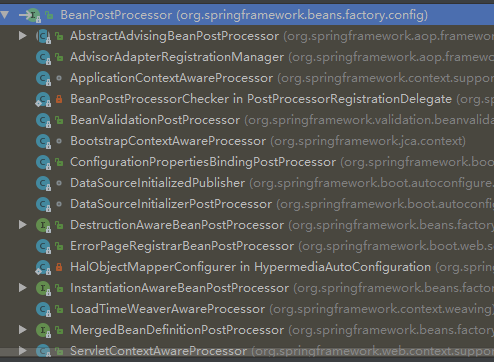Spring扩展点之BeanPostProcessor
前言
BeanPostProcessor接口是Spring中一个非常重要的接口,它的接口定义如下
public interface BeanPostProcessor {
Object postProcessBeforeInitialization(Object bean, String beanName) throws BeansException;
Object postProcessAfterInitialization(Object bean, String beanName) throws BeansException;
}
当你实现了这个接口的时候,Spring会保证在每一个bean对象初始化方法调用之前调用postProcessBeforeInitialization方法,在初始化方法调用之后调用postProcessAfterInitialization
BeanPostProcessor的注册
看过我之前写的IOC源码分析系列文章的同学应该对这个都比较有印象
)
Spring在执行到这的时候会把所有实现BeanPostProcessor接口的实现类都注册到BeanFactory中,一起来看一下实现的细节
protected void registerBeanPostProcessors(ConfigurableListableBeanFactory beanFactory) {
PostProcessorRegistrationDelegate.registerBeanPostProcessors(beanFactory, this);
}
public static void registerBeanPostProcessors(
ConfigurableListableBeanFactory beanFactory, AbstractApplicationContext applicationContext) {
//获取所有BeanPostProcessor的实现类
String[] postProcessorNames = beanFactory.getBeanNamesForType(BeanPostProcessor.class, true, false);
int beanProcessorTargetCount = beanFactory.getBeanPostProcessorCount() + 1 + postProcessorNames.length;
beanFactory.addBeanPostProcessor(new BeanPostProcessorChecker(beanFactory, beanProcessorTargetCount));
// 这里把实现PriorityOrdered接口,Ordered 接口的BeanPostProcessors 和其他类型的BeanPostProcessors 区分开
List<BeanPostProcessor> priorityOrderedPostProcessors = new ArrayList<>();
List<BeanPostProcessor> internalPostProcessors = new ArrayList<>();
List<String> orderedPostProcessorNames = new ArrayList<>();
List<String> nonOrderedPostProcessorNames = new ArrayList<>();
for (String ppName : postProcessorNames) {
if (beanFactory.isTypeMatch(ppName, PriorityOrdered.class)) {
BeanPostProcessor pp = beanFactory.getBean(ppName, BeanPostProcessor.class);
priorityOrderedPostProcessors.add(pp);
if (pp instanceof MergedBeanDefinitionPostProcessor) {
internalPostProcessors.add(pp);
}
}
else if (beanFactory.isTypeMatch(ppName, Ordered.class)) {
orderedPostProcessorNames.add(ppName);
}
else {
nonOrderedPostProcessorNames.add(ppName);
}
}
//对实现了PriorityOrdered接口的按优先级排序
sortPostProcessors(beanFactory, priorityOrderedPostProcessors);
//这里就是注册了,下面会说
registerBeanPostProcessors(beanFactory, priorityOrderedPostProcessors);
List<BeanPostProcessor> orderedPostProcessors = new ArrayList<>();
for (String ppName : orderedPostProcessorNames) {
BeanPostProcessor pp = beanFactory.getBean(ppName, BeanPostProcessor.class);
orderedPostProcessors.add(pp);
if (pp instanceof MergedBeanDefinitionPostProcessor) {
internalPostProcessors.add(pp);
}
}
sortPostProcessors(beanFactory, orderedPostProcessors);
//注册
registerBeanPostProcessors(beanFactory, orderedPostProcessors);
List<BeanPostProcessor> nonOrderedPostProcessors = new ArrayList<>();
for (String ppName : nonOrderedPostProcessorNames) {
BeanPostProcessor pp = beanFactory.getBean(ppName, BeanPostProcessor.class);
nonOrderedPostProcessors.add(pp);
if (pp instanceof MergedBeanDefinitionPostProcessor) {
internalPostProcessors.add(pp);
}
}
//注册
registerBeanPostProcessors(beanFactory, nonOrderedPostProcessors);
// 最后注册常规的
sortPostProcessors(beanFactory, internalPostProcessors);
registerBeanPostProcessors(beanFactory, internalPostProcessors);
beanFactory.addBeanPostProcessor(new ApplicationListenerDetector(applicationContext));
}
可以看到上方的代码就是把这些BeanPostProcessor分为了几类,然后分别根据规则排序后注册进BeanFactory中,而BeanFactory中其实就只是维护了一个BeanPostProcessor的列表而已
private final List<BeanPostProcessor> beanPostProcessors = new ArrayList();
private static void registerBeanPostProcessors(
ConfigurableListableBeanFactory beanFactory, List<BeanPostProcessor> postProcessors) {
for (BeanPostProcessor postProcessor : postProcessors) {
beanFactory.addBeanPostProcessor(postProcessor);
}
}
public void addBeanPostProcessor(BeanPostProcessor beanPostProcessor) {
Assert.notNull(beanPostProcessor, "BeanPostProcessor must not be null");
this.beanPostProcessors.remove(beanPostProcessor);
this.beanPostProcessors.add(beanPostProcessor);
if (beanPostProcessor instanceof InstantiationAwareBeanPostProcessor) {
this.hasInstantiationAwareBeanPostProcessors = true;
}
if (beanPostProcessor instanceof DestructionAwareBeanPostProcessor) {
this.hasDestructionAwareBeanPostProcessors = true;
}
}
执行原理
我们知道Bean的初始化是在定义在容器的刷新过程中,而具体的实现则是由AbstractAutowireCapableBeanFactory.initializeBean()方法完成的。在这个方法中就包含了BeanPostProcessor的调用逻辑
protected Object initializeBean(final String beanName, final Object bean, RootBeanDefinition mbd) {
if (System.getSecurityManager() != null) {
AccessController.doPrivileged(new PrivilegedAction<Object>() {
@Override
public Object run() {
invokeAwareMethods(beanName, bean);
return null;
}
}, getAccessControlContext());
}
else {
invokeAwareMethods(beanName, bean);
}
Object wrappedBean = bean;
if (mbd == null || !mbd.isSynthetic()) {
// BeanPostProcessors 的Before 方法
wrappedBean = applyBeanPostProcessorsBeforeInitialization(wrappedBean, beanName);
}
try {
// 调用初始化方法
invokeInitMethods(beanName, wrappedBean, mbd);
}
catch (Throwable ex) {
throw new BeanCreationException(
(mbd != null ? mbd.getResourceDescription() : null),
beanName, "Invocation of init method failed", ex);
}
if (mbd == null || !mbd.isSynthetic()) {
// BeanPostProcessors 的After方法
wrappedBean = applyBeanPostProcessorsAfterInitialization(wrappedBean, beanName);
}
return wrappedBean;
}
而这里面的执行逻辑我们也可以猜到,无非就是循环遍历所有的BeanPostProcessor,然后一一执行
public Object applyBeanPostProcessorsBeforeInitialization(Object existingBean, String beanName)
throws BeansException {
Object result = existingBean;
for (BeanPostProcessor beanProcessor : getBeanPostProcessors()) {
result = beanProcessor.postProcessBeforeInitialization(result, beanName);
if (result == null) {
return result;
}
}
return result;}
其中applyBeanPostProcessorsAfterInitialization的实现内容跟这个是一样的
但是这里面有一个主意的点,那就是如果具体的实现一但返回null,那么就会跳出for循环,后面的就得不到机会执行了
常见用例
查看这个接口的继承体系,可以看到这个接口的实现类是非常多的,各个实现类的功能如果感兴趣大家可以去慢慢挖掘一下

Spring扩展点之BeanPostProcessor的更多相关文章
- Spring扩展点之Aware接口族
引言 Spring中提供了各种Aware接口,方便从上下文中获取当前的运行环境,比较常见的几个子接口有:BeanFactoryAware,BeanNameAware,ApplicationContex ...
- Spring扩展点-v5.3.9
Spring 扩展点 **本人博客网站 **IT小神 www.itxiaoshen.com 官网地址****:https://spring.io/projects/spring-framework T ...
- Spring扩展点之BeanFactoryPostProcessor
前言 BeanFactoryPostProcessor接口是Spring中一个非常重要的接口,它的接口定义如下 public interface BeanFactoryPostProcessor { ...
- Spring扩展点之FactoryBean接口
前言 首先看一下接口定义 public interface FactoryBean<T> { /** * 返回对象实例 */ @Nullable T getObject() throws ...
- spring扩展点之PropertyPlaceholderConfigurer
原理机制讲解 https://leokongwq.github.io/2016/12/28/spring-PropertyPlaceholderConfigurer.html 使用时多个配置讲解 ht ...
- Spring中的扩展点
Spring作为一个常用的IOC框架,在设计上预留了很多的扩展点,很多第三方开源框架,包括Spring自身也是基于这些扩展点实现的,这很好的体现了对修改关闭.对扩展开放的原则.总的来说Spring的扩 ...
- Spring系列14:IoC容器的扩展点
Spring系列14:IoC容器的扩展点 回顾 知识需要成体系地学习,本系列文章前后有关联,建议按照顺序阅读.上一篇我们详细介绍了Spring Bean的生命周期和丰富的扩展点,没有阅读的强烈建议先阅 ...
- 三万字盘点Spring/Boot的那些常用扩展点
大家好,我是三友. Spring对于每个Java后端程序员来说肯定不陌生,日常开发和面试必备的.本文就来盘点Spring/SpringBoot常见的扩展点,同时也来看看常见的开源框架是如何基于这些扩展 ...
- Spring Boot 中如何使用 Dubbo Activate 扩展点
摘要: 原创出处 www.bysocket.com 「泥瓦匠BYSocket 」欢迎转载,保留摘要,谢谢! 『 公司的核心竞争力在于创新 – <启示录> 』 继续上一篇:< Spri ...
随机推荐
- 04.UTXO:未使用的交易输出,比特币核心概念之一
在比特币系统上其实并不存在“账户”,而只有“地址”.只要你愿意,你就可以在比特币区块链上开设无限多个钱包地址,你拥有的比特币数量是你所有的钱包地址中比特币的总和.比特币系统并不会帮你把这些地址汇总起来 ...
- java XML解析防止外部实体注入
/** * 增加防止部实体注入逻辑 * <功能详细描述> * @param reader * @throws SAXException * @see [类.类#方法.类#成员] */ pu ...
- 初始v4l2(六)-------根据虚拟驱动vivi的使用彻底分析摄像头驱动
前面的几篇文章已经分析了v4l2的框架,对框架的分析是比较粗浅的,能基本清楚函数之间的调用过程.但是很多内容并没有分析,比如说里面有很多ioctl,并没有分析哪些ioctl是必须的,也没有分析如何从应 ...
- IDEA 一键生成所有setter方法(GenerateAllSetter插件)
GenerateAllSetter插件使用效果如下: alt+enter快捷键选择Generate all setter 之后就会自动生成其中的所有setter方法 下面介绍idea安装步骤: alt ...
- 莫烦TensorFlow_04 placeholder
import tensorflow as tf input1 = tf.placeholder(tf.float32) input2 = tf.placeholder(tf.float32) outp ...
- redis 在 windows 中的安装
redis 在 windows 中的安装 redis 官方并没有提供 redis 的 windows 版本.但是微软提供了 redis 的 windows 版本.有2.8和3.0版本.3.0版本支持集 ...
- 刘长峰 js基础讲座笔记 课后作业
1.DataType Assert 数据类型断言 一.typeof : 判断变量的类型 ,返回字符串 typeof a 返回 'undefined' .'boolean' .'string' .' ...
- [LeetCode] 307. Range Sum Query - Mutable 区域和检索 - 可变
Given an integer array nums, find the sum of the elements between indices i and j (i ≤ j), inclusive ...
- [LeetCode] 39. Combination Sum 组合之和
Given a set of candidate numbers (candidates) (without duplicates) and a target number (target), fin ...
- 搭建 Web 网站常用技能
为软件创建专用数据库及其账号 create database if not exists gitea default charset = utf8mb4; grant ALL PRIVILEGES o ...
